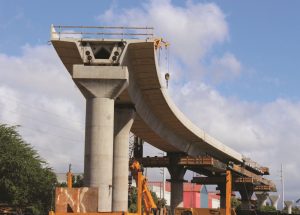19-03, Audit of the Honolulu Authority for Rapid Transportation: Report 1
Posted on Jan 15, 2019 in Summary| As the Honolulu Rail Transit Project progressed, costs swelled from $5.122 billion in 2012 to $9.188 billion in 2018. |
|
AUDITOR’S SUMMARY IN 2012, THE CITY AND COUNTY OF HONOLULU (City) broke ground on a 20.1 mile elevated rail transit system extending from Kapolei to Ala Moana. We found that, as the Honolulu Rail Transit Project (Project) progressed and costs swelled from $5.122 billion in 2012 to $9.188 billion in 2018, Honolulu Authority for Rapid Transportation (HART) began reporting information to the public that often contradicted its own internal projections or differed from what it was telling the Federal Transit Administration (FTA). Since federal funding for the Project is fixed at $1.55 billion, the financial burden on State residents, as well as visitors, has escalated along with the estimated costs to complete Honolulu’s rail transit system. What Did We Find? Why Did These Problems Occur? Additionally, as early as April 2014, HART began reporting different project contingency amounts to different audiences, which may have distorted the Project’s financial outlook and delayed triggering of a recovery plan. Among other things, we found that throughout 2015, while HART was grappling with major unanticipated cost increases, HART’s monthly progress reports to the Board failed to include updated project cost estimates and opening date projections that were otherwise reported in FTA oversight contractor meetings and documented in Why Do These Problems Matter? By Fall 2018, the Project was about 46 percent completed, with roughly 10 miles of elevated guideway and a maintenance and storage facility built in West O’ahu. In September 2018, HART’s board approved the solicitation of a public-private partnership, or “P3,” to help pay the now $1.4 billion cost of the city center section of the rail project and build a Pearl Highlands Parking Garage and Transit Center. In its 2018 revised recovery plan, released on November 19, 2018, HART wrote: “Consistent with FTA direction, the Project will be completed at a cost of under $8.299 billion1 excluding financing costs with a Revenue Service Date (RSD) for the full system no later than September 2026.” But then HART went on to make its own optimistic projection: “HART’s commitment to the residents of Honolulu is to complete the Project at a cost no greater than $8.165 billion2 and open for full revenue service by December 2025.” |
| 1 The FTA’s recommended cost estimate is $9.188 including financing costs, as of November 2018. 2 HART’s total project cost estimate is $9.020 including financing costs, as of November 2018. |
| Clarification: The Auditor’s Summary has been revised to clarify that HART’s board approved pursuing a public-private partnership (P3) to finance and construct the city center section of the Project and the Pearl Highlands Parking Garage and Transit Center, removing a clause that implied the City lacked the funds to complete those projects. |
